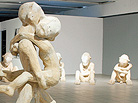Towards the Other. Obserwations and interventions

Artists:
Paweł Althamer
Sylwester Ambroziak
Małgorzata Jabłońska i Piotr Szewczyk
Anna Konik
Grzegorz Kowalski
Przemysław Kwiek
Jarosław Modzelewski
Zbigniew Libera
Joanna Rajkowska
Grzegorz Sztwiertnia
Jan Świdziński
Jerzy Truszkowski
Krzysztof Wodiczko
Alicja Żebrowska
Artur Żmijewski

Towards the Other. Obserwations and interventions Whenever we — artists and scholars — talk, we talk about people; we talk about them in different forms, in different colours, in different...

“You cannot love words. You cannot be in love with words. You can love another human being. That's perfection!”
Bess in Breaking the Waves by Lars von Trier
The presentation entitled “Towards the Other. Observations and Interventions” is a crowning point of all the thematic exhibitions shown within the Biennial 'Towards Values'. This concept refers to the basic ideas of humanity, dialogue, man encountering another man. The motto used in the Biennial “What is required is an act which a human does with all his or her being… I am chosen and I choose” (Martin Buber), serves to underline its dynamic character.
The project “Towards the Other”chronicles these images and spheres of life which have been ignored in the everyday realm of success and eternal youth: old age, illness, poverty, social exclusion. On the other hand, it is a catalogue of socially engaged art projects, the ones that 'head for' another human being and their problems.
Nowadays, the issue of 'the Other' is being thoroughly examined in fine arts, just like as it is in the field of humanities. The very category of 'the Other' is variable. It no longer exclusively denotes the old, the sick, the jobless, the homeless, emigrants or victims of gender-specific exclusion. In each case, the type of 'the Other' is context-dependent and based on the division between the powerful and the weak. Inevitably, such a portrayal is going to be incomplete and fragmentary; but owing to this, it will not be subject to ideologisation. The domain of art might be one of the last territories where 'the Other' is not used as an alibi, provided only to serve some groups' vested interests.
Today, interventionist engaged art seems to be coming to the forefront of Polish painting, following 15 years of the domination of other genres, such as: critical art, pop-banalist painting, art that blends in with everyday reality. In fact, it naturally originates from the latter forms. A vast number of socially engaged works provide evidence that activism is in fashion. This creates additional challenges.
However, one might want to ask whether the exhibition of the excluded 'ousted' subjects unwittingly places them into another ghetto, the ghetto that the sphere of art has itself become, as it has also been driven away from general discourse. In view of this, is it not advisable to seek some novel ways of reaching the audience and making an impact on reality? Perhaps the old benchmarks for art (innovativeness, authenticity, form, and suchlike) will be replaced with a new point of reference, that is efficiency, especially when it comes to interventionist art. Elaborating on the quote from Hans Haacke, who said that „[nowadays] the problem is not only to say something, to take a position but also to create a productive provocation. The sensitivity of the context into which one inserts something or the manner in which one does it, can trigger a public debate. However, it does not work well if the press fails to play its role of amplifier and forum for debate. […] A successful happening that gets 5 minutes of television air-time can have as great a political effect as 500 000 protesters [who haven't been shown on TV]”, this review could be considered to be a summary of the phase which seems to be coming to a climax in recent years. It is the stage during which some focusing methods, such as an Open Form and contextual art, are realised.
The exhibition and the publication, which is being prepared, is entitled Towards the Other, and includes classical works related to the issue, as well as new projects. Some of these were created within the framework of this project. The curator's selection of a dozen or so artists representing different generations cannot aspire to explore the issue in its entirety. The future of interventionist art and the human-centric considerations which are related to it, will be probably realised in different fields — in the territories occupied by marketing, programming, public relations and television experts. It will entail not only the application of some of their methods, but also the creation of completely new art, which pursues a clear modernising objective of making a profound impact on reality. Supposing that at some point in time this somewhat utopian programme is completed, then the artists invited to the project “Towards the Other” will be considered its important ancestors.
Stanisław Ruksza, curator of the exhibition







